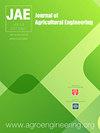采用滞后补偿算法和脉宽调制喷雾技术的无人机可变速率喷雾系统
IF 2.5
4区 农林科学
Q2 AGRICULTURAL ENGINEERING
引用次数: 0
摘要
为了保证变速喷雾系统在不同飞行速度下能够按照处方图进行无人机喷雾,本文研究了变速喷雾过程中变速喷雾系统的响应时间和喷嘴压力波动等重要因素。VRS系统采用滞后补偿算法(LCA)来抵消由于系统响应延迟引起的液滴沉积位置滞后。此外,采用脉宽调制(PWM)电磁阀控制变流量喷雾系统的喷嘴流量,并建立了喷雾速率(L min-1)和各电磁阀开启时间相对比例(占空比)的数学模型。通过室内实验测量了不同占空比(50%~90%)下的压降和电磁阀响应时间。同时,通过不同飞行速度(4m s-1、5m s-1、6m s-1)下的室外实验,测试了VRS系统的滞后距离(LD)、喷雾精度和液滴沉积特性。结果表明,LCA可以有效地减小滞后距离。有LCA的VRS系统的滞后距离(LD)值在-0.27 ~ 0.78m之间,平均为0.32m;无LCA的VRS系统的滞后距离(LD)值增加到3.5~4.3m,平均为3.87m。总体喷雾位置精度在91.56%~97.32%之间。此外,考虑喷雾量,使用水敏纸(WSP)测定喷雾覆盖率和沉积密度,以评估喷雾应用性能。VRS系统可以为杀虫剂和杀菌剂植保产品提供最合适的喷雾量。优化后的VRS系统在处方图的基础上,能够实现精准的农药喷洒,同时达到理想的喷洒覆盖率和喷洒密度。本文章由计算机程序翻译,如有差异,请以英文原文为准。
Variable-rate spray system for unmanned aerial applications using lag compensation algorithm and pulse width modulation spray technology
To ensure that a variable-rate spray (VRS) system can perform unmanned aerial spray in accordance with a prescription map at different flight speeds, we examine in this paper such significant factors as the response time of the VRS system and the pressure fluctuation of the nozzle during the variable-rate spraying process. The VRS system uses a lag compensation algorithm (LCA) to counteract the droplet deposition position lag caused by the system response delay. In addition, pulse width modulated (PWM) solenoid valves are used for controlling the flowrates of the nozzles on the variable-rate spray system, and a mathematical model was constructed for the spray rate (L min-1) and the relative proportion of time (duty cycle) each solenoid valve is open. The pressure drop and solenoid valve response time at different duty cycles (50%~90%) were measured by indoor experiments. Meanwhile, the lag distance (LD), spray accuracy, and droplet deposition characteristics of the VRS system were tested by conducting outdoor experiments at different flight speeds (4m s-1, 5m s-1, 6m s-1). The results show that LCA can effectively reduce the lag distance. The lag distance (LD) values of the VRS system with LCA ranged from -0.27 to 0.78m with an average value of 0.32m, while without LCA, the LD values increased to 3.5~4.3m with an average value of 3.87m. The overall spray position accuracy was in the range of 91.56%~97.32%. Furthermore, the spray coverage and deposition density, determined using water sensitive paper (WSP), were used to evaluate the spray application performance taking into account the spray volume applied. The VRS system can provide the most suitable spray volumes for insecticide and fungicide plant protection products. Based on a prescription map, the optimized VRS system can achieve accurate pesticide spraying as well as desirable spray coverage and deposition density.
求助全文
通过发布文献求助,成功后即可免费获取论文全文。
去求助
来源期刊

Journal of Agricultural Engineering
AGRICULTURAL ENGINEERING-
CiteScore
2.30
自引率
5.60%
发文量
40
审稿时长
10 weeks
期刊介绍:
The Journal of Agricultural Engineering (JAE) is the official journal of the Italian Society of Agricultural Engineering supported by University of Bologna, Italy. The subject matter covers a complete and interdisciplinary range of research in engineering for agriculture and biosystems.
 求助内容:
求助内容: 应助结果提醒方式:
应助结果提醒方式:


